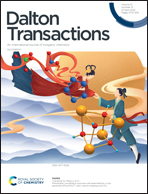Metal-to-metal communication during the spin state transition of a [2 × 2] Fe(ii) metallogrid at equilibrium and out-of-equilibrium conditions†
Abstract
Spin crossover (SCO) complexes are prototypes of materials with bi- or multi-stability in the solid state. The structural evolution during their spin transition is a key feature to establish the foundations of how to utilize this type of material. So far, ultrafast time-resolved structural investigations of SCO solids have been focused on monometallic complexes, though an increasing number of oligometallic SCO complexes showing cooperativity effects are being reported. Here, we used single crystal X-ray crystallography and time-resolved pink Laue photocrystallography to study the molecular reorganisation during the thermal and photoinduced SCO of a [2 × 2] tetranuclear metallogrid of the form [FeII4LMe4](BF4)4·2MeCN ([LMe]− = 4-methyl-3,5-bis{6-(2,2′-bipyridyl)}pyrazolate). A multitemperature crystallographic investigation on single crystals reveals an effective communication between the metal centres during thermal SCO, observed by the simultaneous transformation of the coordination polyhedra of both crystallographic-symmetry independent metal atoms accompanying the SCO in only one of them. Time-resolved photocrystallography results reveal the different molecular responses between mononuclear and oligonuclear complexes, after light irradiation with a picosecond laser pulse. While mononuclear SCO complexes reorganise once during the first nanosecond after excitation, the tetranuclear metallogrid exhibits a multiple structural rearrangement in the same span of time. Such behaviour is attributed to the elastic communication between metal atoms, which allows the propagation of a short-range elastic distortion over the entire Fe4 grid complex. The present study sheds light on the importance of strong elastic coupling of metal atoms during the correlated spin transition of oligometallic complexes.
![Graphical abstract: Metal-to-metal communication during the spin state transition of a [2 × 2] Fe(ii) metallogrid at equilibrium and out-of-equilibrium conditions](/en/Image/Get?imageInfo.ImageType=GA&imageInfo.ImageIdentifier.ManuscriptID=D1DT04255F&imageInfo.ImageIdentifier.Year=2022)


 Please wait while we load your content...
Please wait while we load your content...